Research Applications in Global Business: A Case Study of LEVC Taxis
VerifiedAdded on 2023/06/12
|15
|4070
|500
Case Study
AI Summary
This paper provides an overview of global business, using LEVC taxi business as a case study. It analyzes the industry, relevant theories, and sectors. The central issue explores how LEVC offers environmental solutions through electric car production, supported by an external article. Critical success factors, such as accessible information and collaboration, are identified. The analysis incorporates Porter's Five Forces and manufacturing theory, comparing electric and gasoline car costs and emissions. The study also addresses limitations, like excluding the impact of oil extraction and focusing on emissions rather than broader environmental effects. Recommendations are provided to enhance LEVC's performance and sustainability.

Student’s Last Name1
Research Applications in Global Business
By (Name)
Course
Professor
University
Date
Research Applications in Global Business
By (Name)
Course
Professor
University
Date
Paraphrase This Document
Need a fresh take? Get an instant paraphrase of this document with our AI Paraphraser
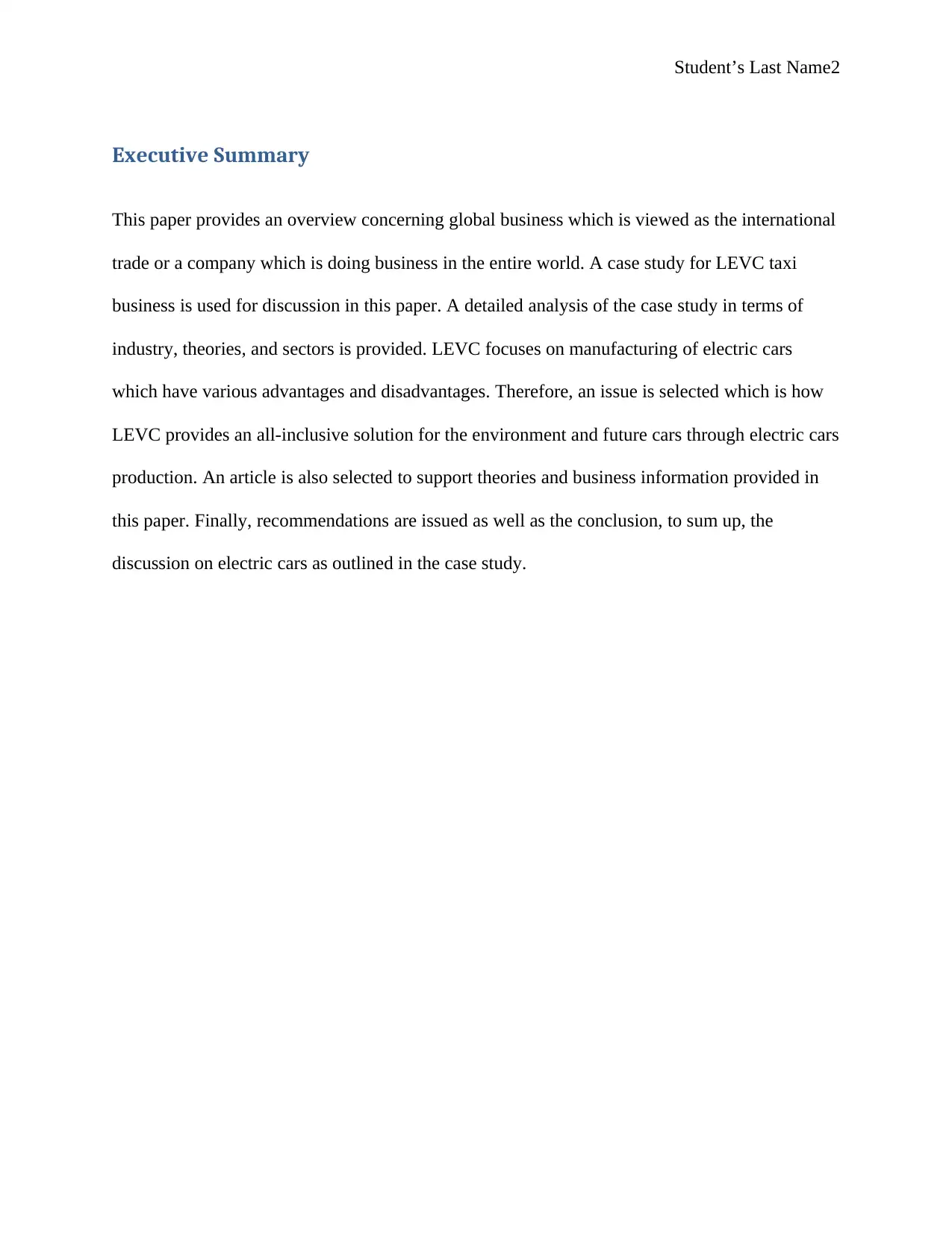
Student’s Last Name2
Executive Summary
This paper provides an overview concerning global business which is viewed as the international
trade or a company which is doing business in the entire world. A case study for LEVC taxi
business is used for discussion in this paper. A detailed analysis of the case study in terms of
industry, theories, and sectors is provided. LEVC focuses on manufacturing of electric cars
which have various advantages and disadvantages. Therefore, an issue is selected which is how
LEVC provides an all-inclusive solution for the environment and future cars through electric cars
production. An article is also selected to support theories and business information provided in
this paper. Finally, recommendations are issued as well as the conclusion, to sum up, the
discussion on electric cars as outlined in the case study.
Executive Summary
This paper provides an overview concerning global business which is viewed as the international
trade or a company which is doing business in the entire world. A case study for LEVC taxi
business is used for discussion in this paper. A detailed analysis of the case study in terms of
industry, theories, and sectors is provided. LEVC focuses on manufacturing of electric cars
which have various advantages and disadvantages. Therefore, an issue is selected which is how
LEVC provides an all-inclusive solution for the environment and future cars through electric cars
production. An article is also selected to support theories and business information provided in
this paper. Finally, recommendations are issued as well as the conclusion, to sum up, the
discussion on electric cars as outlined in the case study.
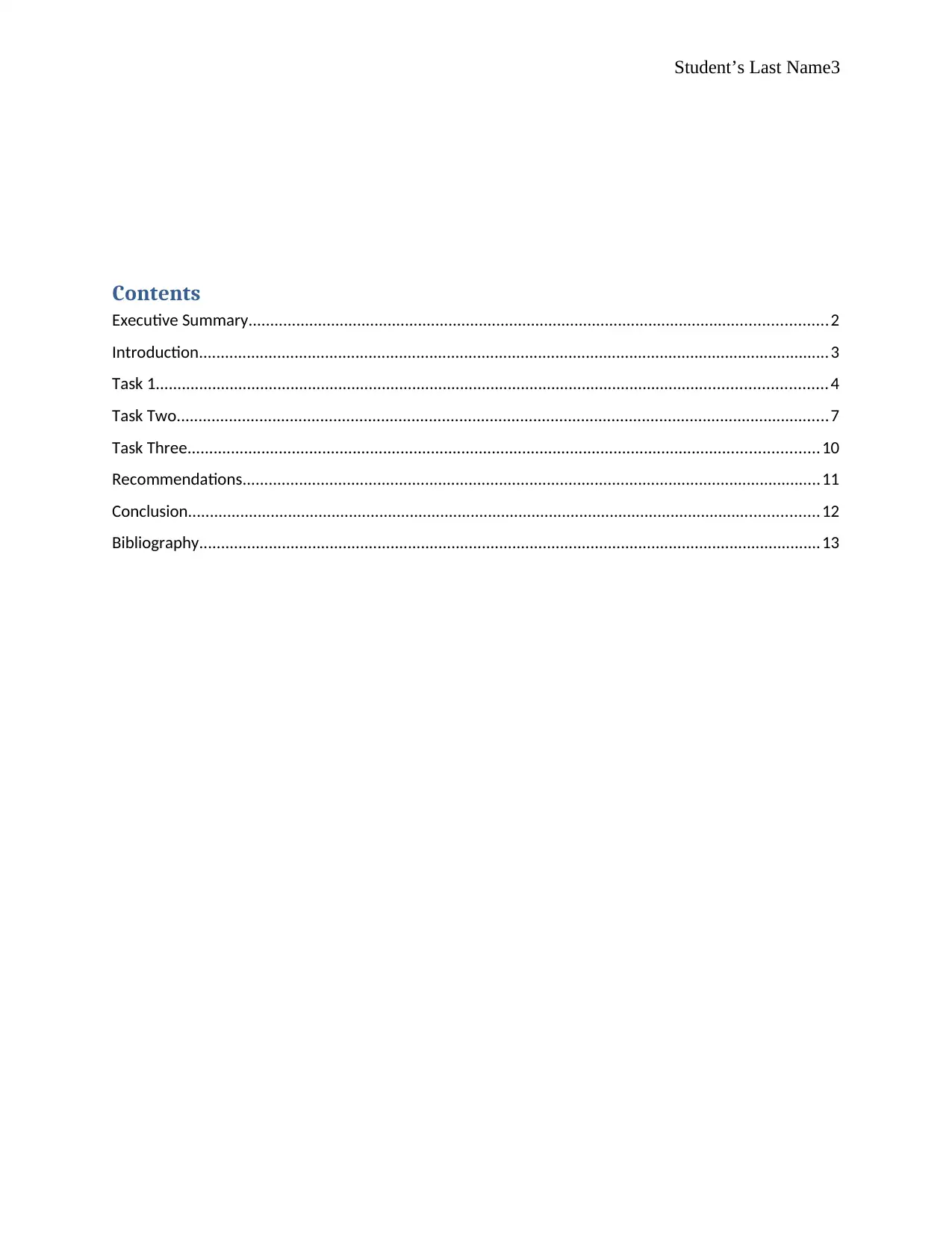
Student’s Last Name3
Contents
Executive Summary.....................................................................................................................................2
Introduction.................................................................................................................................................3
Task 1..........................................................................................................................................................4
Task Two......................................................................................................................................................7
Task Three.................................................................................................................................................10
Recommendations.....................................................................................................................................11
Conclusion.................................................................................................................................................12
Bibliography...............................................................................................................................................13
Contents
Executive Summary.....................................................................................................................................2
Introduction.................................................................................................................................................3
Task 1..........................................................................................................................................................4
Task Two......................................................................................................................................................7
Task Three.................................................................................................................................................10
Recommendations.....................................................................................................................................11
Conclusion.................................................................................................................................................12
Bibliography...............................................................................................................................................13
⊘ This is a preview!⊘
Do you want full access?
Subscribe today to unlock all pages.

Trusted by 1+ million students worldwide
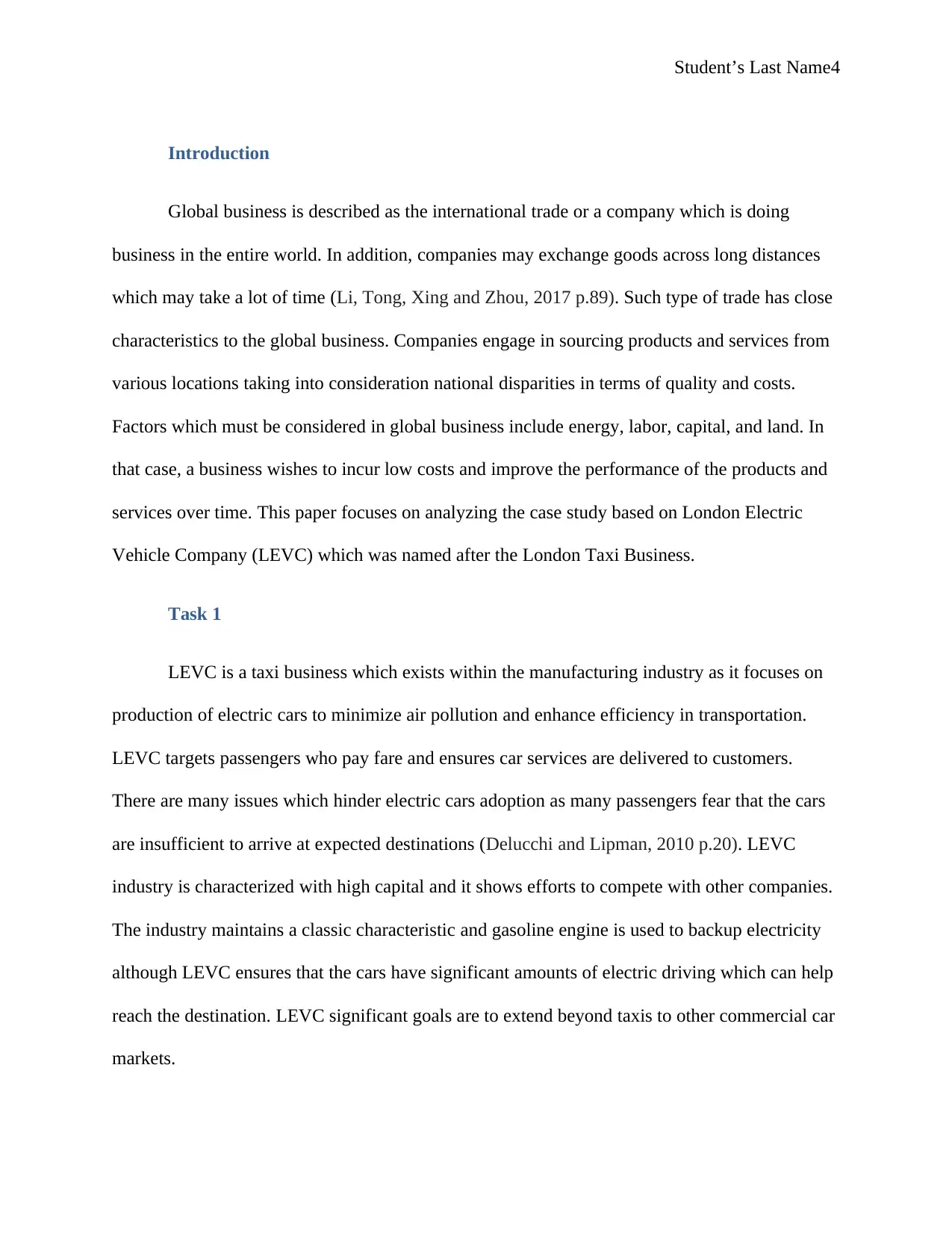
Student’s Last Name4
Introduction
Global business is described as the international trade or a company which is doing
business in the entire world. In addition, companies may exchange goods across long distances
which may take a lot of time (Li, Tong, Xing and Zhou, 2017 p.89). Such type of trade has close
characteristics to the global business. Companies engage in sourcing products and services from
various locations taking into consideration national disparities in terms of quality and costs.
Factors which must be considered in global business include energy, labor, capital, and land. In
that case, a business wishes to incur low costs and improve the performance of the products and
services over time. This paper focuses on analyzing the case study based on London Electric
Vehicle Company (LEVC) which was named after the London Taxi Business.
Task 1
LEVC is a taxi business which exists within the manufacturing industry as it focuses on
production of electric cars to minimize air pollution and enhance efficiency in transportation.
LEVC targets passengers who pay fare and ensures car services are delivered to customers.
There are many issues which hinder electric cars adoption as many passengers fear that the cars
are insufficient to arrive at expected destinations (Delucchi and Lipman, 2010 p.20). LEVC
industry is characterized with high capital and it shows efforts to compete with other companies.
The industry maintains a classic characteristic and gasoline engine is used to backup electricity
although LEVC ensures that the cars have significant amounts of electric driving which can help
reach the destination. LEVC significant goals are to extend beyond taxis to other commercial car
markets.
Introduction
Global business is described as the international trade or a company which is doing
business in the entire world. In addition, companies may exchange goods across long distances
which may take a lot of time (Li, Tong, Xing and Zhou, 2017 p.89). Such type of trade has close
characteristics to the global business. Companies engage in sourcing products and services from
various locations taking into consideration national disparities in terms of quality and costs.
Factors which must be considered in global business include energy, labor, capital, and land. In
that case, a business wishes to incur low costs and improve the performance of the products and
services over time. This paper focuses on analyzing the case study based on London Electric
Vehicle Company (LEVC) which was named after the London Taxi Business.
Task 1
LEVC is a taxi business which exists within the manufacturing industry as it focuses on
production of electric cars to minimize air pollution and enhance efficiency in transportation.
LEVC targets passengers who pay fare and ensures car services are delivered to customers.
There are many issues which hinder electric cars adoption as many passengers fear that the cars
are insufficient to arrive at expected destinations (Delucchi and Lipman, 2010 p.20). LEVC
industry is characterized with high capital and it shows efforts to compete with other companies.
The industry maintains a classic characteristic and gasoline engine is used to backup electricity
although LEVC ensures that the cars have significant amounts of electric driving which can help
reach the destination. LEVC significant goals are to extend beyond taxis to other commercial car
markets.
Paraphrase This Document
Need a fresh take? Get an instant paraphrase of this document with our AI Paraphraser
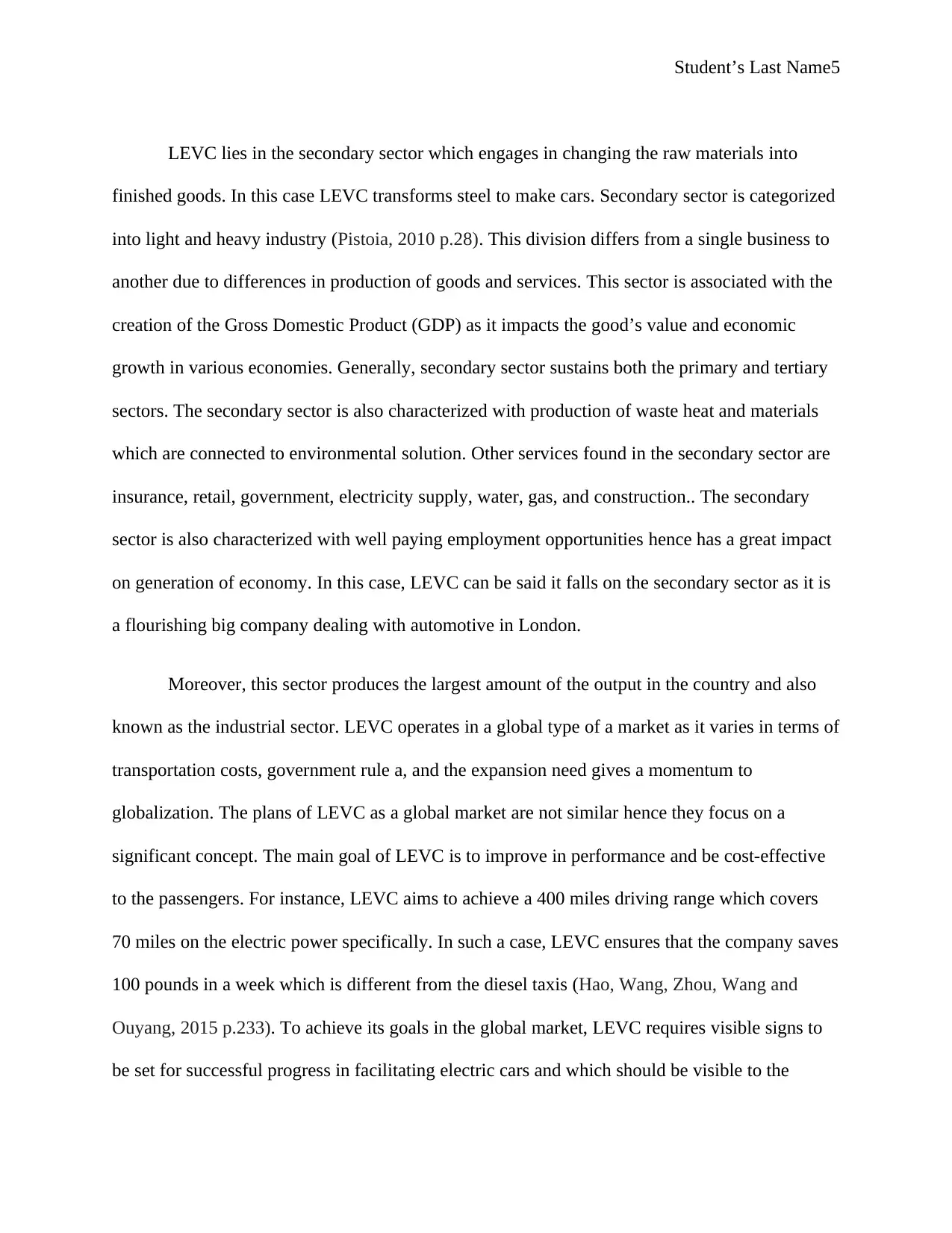
Student’s Last Name5
LEVC lies in the secondary sector which engages in changing the raw materials into
finished goods. In this case LEVC transforms steel to make cars. Secondary sector is categorized
into light and heavy industry (Pistoia, 2010 p.28). This division differs from a single business to
another due to differences in production of goods and services. This sector is associated with the
creation of the Gross Domestic Product (GDP) as it impacts the good’s value and economic
growth in various economies. Generally, secondary sector sustains both the primary and tertiary
sectors. The secondary sector is also characterized with production of waste heat and materials
which are connected to environmental solution. Other services found in the secondary sector are
insurance, retail, government, electricity supply, water, gas, and construction.. The secondary
sector is also characterized with well paying employment opportunities hence has a great impact
on generation of economy. In this case, LEVC can be said it falls on the secondary sector as it is
a flourishing big company dealing with automotive in London.
Moreover, this sector produces the largest amount of the output in the country and also
known as the industrial sector. LEVC operates in a global type of a market as it varies in terms of
transportation costs, government rule a, and the expansion need gives a momentum to
globalization. The plans of LEVC as a global market are not similar hence they focus on a
significant concept. The main goal of LEVC is to improve in performance and be cost-effective
to the passengers. For instance, LEVC aims to achieve a 400 miles driving range which covers
70 miles on the electric power specifically. In such a case, LEVC ensures that the company saves
100 pounds in a week which is different from the diesel taxis (Hao, Wang, Zhou, Wang and
Ouyang, 2015 p.233). To achieve its goals in the global market, LEVC requires visible signs to
be set for successful progress in facilitating electric cars and which should be visible to the
LEVC lies in the secondary sector which engages in changing the raw materials into
finished goods. In this case LEVC transforms steel to make cars. Secondary sector is categorized
into light and heavy industry (Pistoia, 2010 p.28). This division differs from a single business to
another due to differences in production of goods and services. This sector is associated with the
creation of the Gross Domestic Product (GDP) as it impacts the good’s value and economic
growth in various economies. Generally, secondary sector sustains both the primary and tertiary
sectors. The secondary sector is also characterized with production of waste heat and materials
which are connected to environmental solution. Other services found in the secondary sector are
insurance, retail, government, electricity supply, water, gas, and construction.. The secondary
sector is also characterized with well paying employment opportunities hence has a great impact
on generation of economy. In this case, LEVC can be said it falls on the secondary sector as it is
a flourishing big company dealing with automotive in London.
Moreover, this sector produces the largest amount of the output in the country and also
known as the industrial sector. LEVC operates in a global type of a market as it varies in terms of
transportation costs, government rule a, and the expansion need gives a momentum to
globalization. The plans of LEVC as a global market are not similar hence they focus on a
significant concept. The main goal of LEVC is to improve in performance and be cost-effective
to the passengers. For instance, LEVC aims to achieve a 400 miles driving range which covers
70 miles on the electric power specifically. In such a case, LEVC ensures that the company saves
100 pounds in a week which is different from the diesel taxis (Hao, Wang, Zhou, Wang and
Ouyang, 2015 p.233). To achieve its goals in the global market, LEVC requires visible signs to
be set for successful progress in facilitating electric cars and which should be visible to the
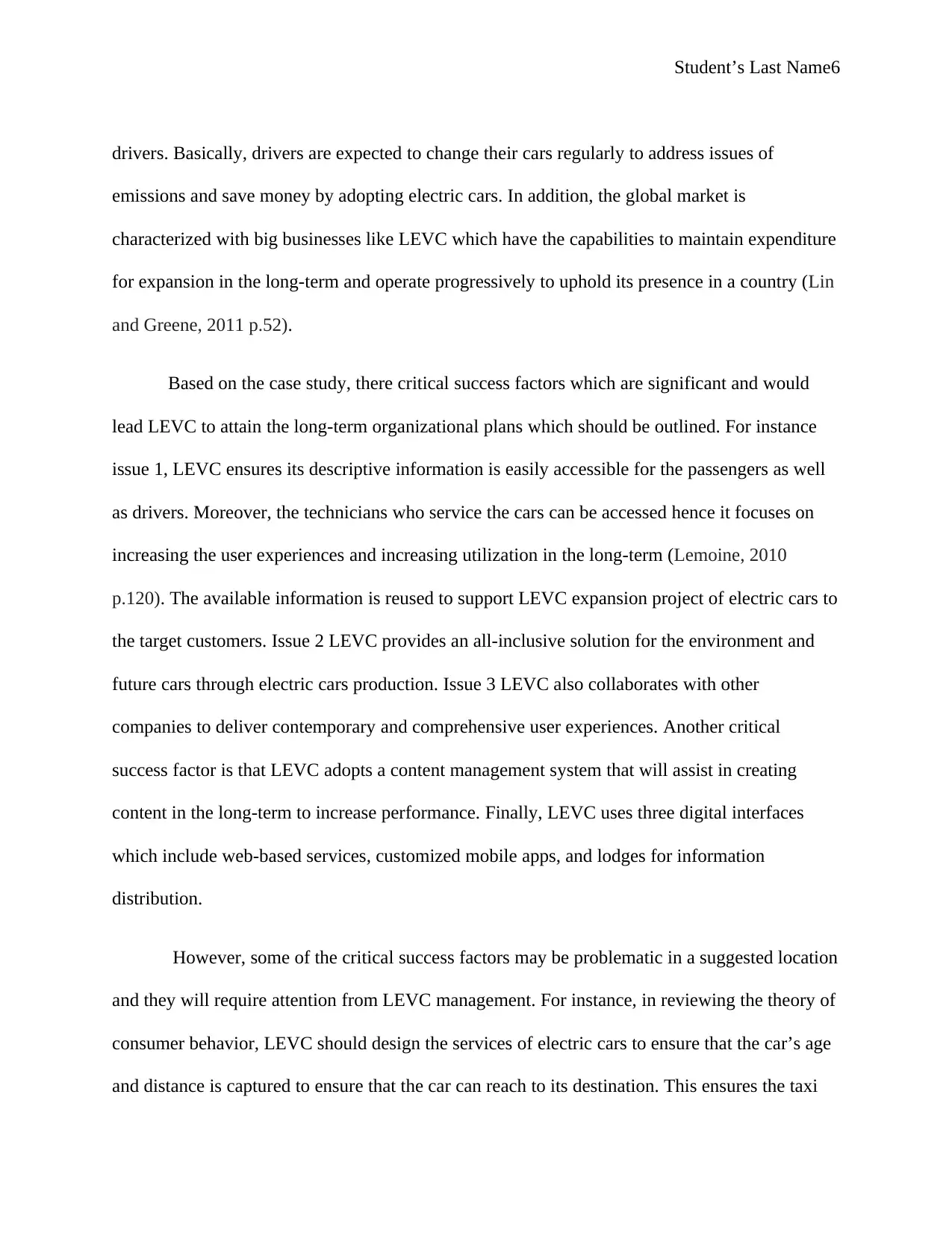
Student’s Last Name6
drivers. Basically, drivers are expected to change their cars regularly to address issues of
emissions and save money by adopting electric cars. In addition, the global market is
characterized with big businesses like LEVC which have the capabilities to maintain expenditure
for expansion in the long-term and operate progressively to uphold its presence in a country (Lin
and Greene, 2011 p.52).
Based on the case study, there critical success factors which are significant and would
lead LEVC to attain the long-term organizational plans which should be outlined. For instance
issue 1, LEVC ensures its descriptive information is easily accessible for the passengers as well
as drivers. Moreover, the technicians who service the cars can be accessed hence it focuses on
increasing the user experiences and increasing utilization in the long-term (Lemoine, 2010
p.120). The available information is reused to support LEVC expansion project of electric cars to
the target customers. Issue 2 LEVC provides an all-inclusive solution for the environment and
future cars through electric cars production. Issue 3 LEVC also collaborates with other
companies to deliver contemporary and comprehensive user experiences. Another critical
success factor is that LEVC adopts a content management system that will assist in creating
content in the long-term to increase performance. Finally, LEVC uses three digital interfaces
which include web-based services, customized mobile apps, and lodges for information
distribution.
However, some of the critical success factors may be problematic in a suggested location
and they will require attention from LEVC management. For instance, in reviewing the theory of
consumer behavior, LEVC should design the services of electric cars to ensure that the car’s age
and distance is captured to ensure that the car can reach to its destination. This ensures the taxi
drivers. Basically, drivers are expected to change their cars regularly to address issues of
emissions and save money by adopting electric cars. In addition, the global market is
characterized with big businesses like LEVC which have the capabilities to maintain expenditure
for expansion in the long-term and operate progressively to uphold its presence in a country (Lin
and Greene, 2011 p.52).
Based on the case study, there critical success factors which are significant and would
lead LEVC to attain the long-term organizational plans which should be outlined. For instance
issue 1, LEVC ensures its descriptive information is easily accessible for the passengers as well
as drivers. Moreover, the technicians who service the cars can be accessed hence it focuses on
increasing the user experiences and increasing utilization in the long-term (Lemoine, 2010
p.120). The available information is reused to support LEVC expansion project of electric cars to
the target customers. Issue 2 LEVC provides an all-inclusive solution for the environment and
future cars through electric cars production. Issue 3 LEVC also collaborates with other
companies to deliver contemporary and comprehensive user experiences. Another critical
success factor is that LEVC adopts a content management system that will assist in creating
content in the long-term to increase performance. Finally, LEVC uses three digital interfaces
which include web-based services, customized mobile apps, and lodges for information
distribution.
However, some of the critical success factors may be problematic in a suggested location
and they will require attention from LEVC management. For instance, in reviewing the theory of
consumer behavior, LEVC should design the services of electric cars to ensure that the car’s age
and distance is captured to ensure that the car can reach to its destination. This ensures the taxi
⊘ This is a preview!⊘
Do you want full access?
Subscribe today to unlock all pages.

Trusted by 1+ million students worldwide
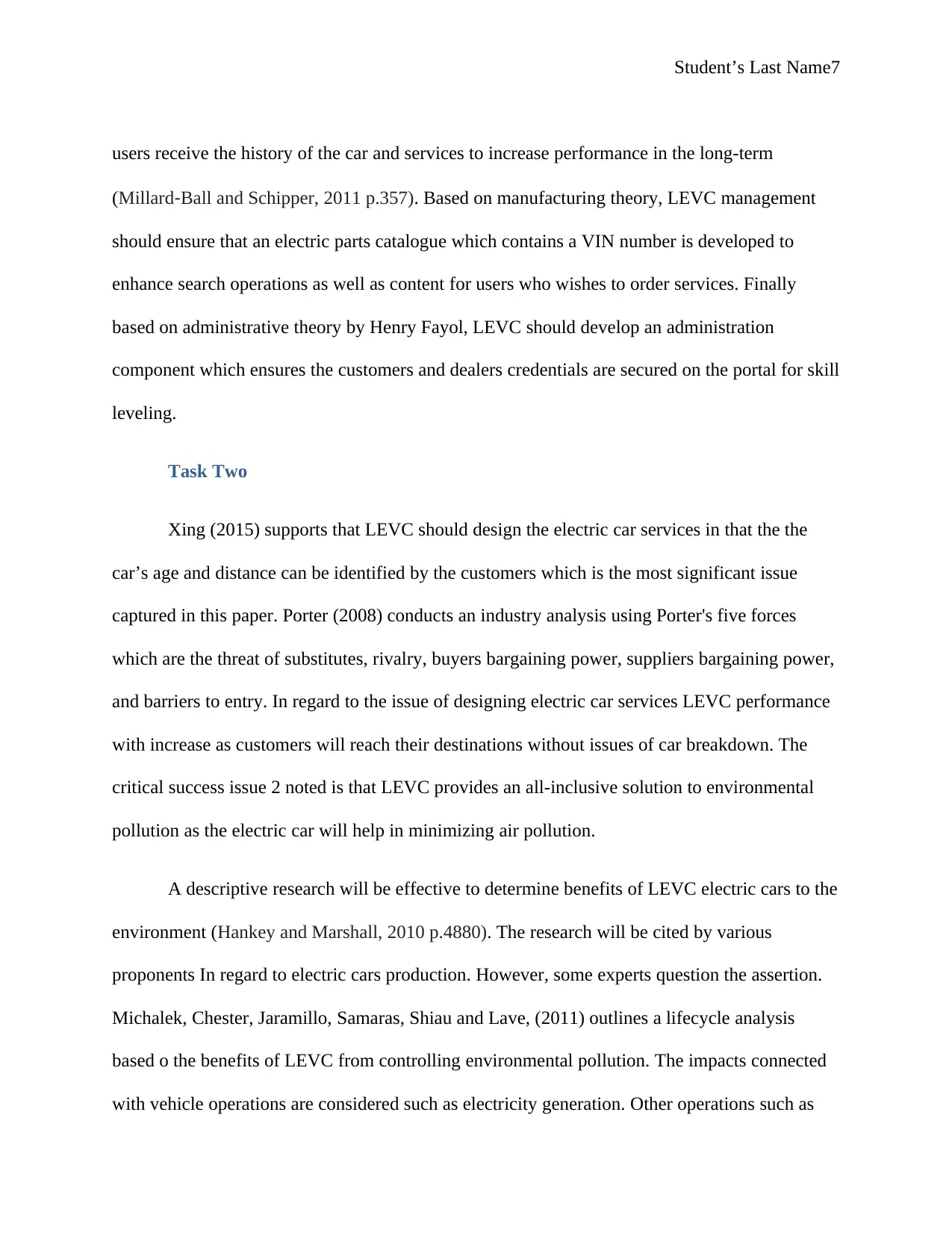
Student’s Last Name7
users receive the history of the car and services to increase performance in the long-term
(Millard‐Ball and Schipper, 2011 p.357). Based on manufacturing theory, LEVC management
should ensure that an electric parts catalogue which contains a VIN number is developed to
enhance search operations as well as content for users who wishes to order services. Finally
based on administrative theory by Henry Fayol, LEVC should develop an administration
component which ensures the customers and dealers credentials are secured on the portal for skill
leveling.
Task Two
Xing (2015) supports that LEVC should design the electric car services in that the the
car’s age and distance can be identified by the customers which is the most significant issue
captured in this paper. Porter (2008) conducts an industry analysis using Porter's five forces
which are the threat of substitutes, rivalry, buyers bargaining power, suppliers bargaining power,
and barriers to entry. In regard to the issue of designing electric car services LEVC performance
with increase as customers will reach their destinations without issues of car breakdown. The
critical success issue 2 noted is that LEVC provides an all-inclusive solution to environmental
pollution as the electric car will help in minimizing air pollution.
A descriptive research will be effective to determine benefits of LEVC electric cars to the
environment (Hankey and Marshall, 2010 p.4880). The research will be cited by various
proponents In regard to electric cars production. However, some experts question the assertion.
Michalek, Chester, Jaramillo, Samaras, Shiau and Lave, (2011) outlines a lifecycle analysis
based o the benefits of LEVC from controlling environmental pollution. The impacts connected
with vehicle operations are considered such as electricity generation. Other operations such as
users receive the history of the car and services to increase performance in the long-term
(Millard‐Ball and Schipper, 2011 p.357). Based on manufacturing theory, LEVC management
should ensure that an electric parts catalogue which contains a VIN number is developed to
enhance search operations as well as content for users who wishes to order services. Finally
based on administrative theory by Henry Fayol, LEVC should develop an administration
component which ensures the customers and dealers credentials are secured on the portal for skill
leveling.
Task Two
Xing (2015) supports that LEVC should design the electric car services in that the the
car’s age and distance can be identified by the customers which is the most significant issue
captured in this paper. Porter (2008) conducts an industry analysis using Porter's five forces
which are the threat of substitutes, rivalry, buyers bargaining power, suppliers bargaining power,
and barriers to entry. In regard to the issue of designing electric car services LEVC performance
with increase as customers will reach their destinations without issues of car breakdown. The
critical success issue 2 noted is that LEVC provides an all-inclusive solution to environmental
pollution as the electric car will help in minimizing air pollution.
A descriptive research will be effective to determine benefits of LEVC electric cars to the
environment (Hankey and Marshall, 2010 p.4880). The research will be cited by various
proponents In regard to electric cars production. However, some experts question the assertion.
Michalek, Chester, Jaramillo, Samaras, Shiau and Lave, (2011) outlines a lifecycle analysis
based o the benefits of LEVC from controlling environmental pollution. The impacts connected
with vehicle operations are considered such as electricity generation. Other operations such as
Paraphrase This Document
Need a fresh take? Get an instant paraphrase of this document with our AI Paraphraser
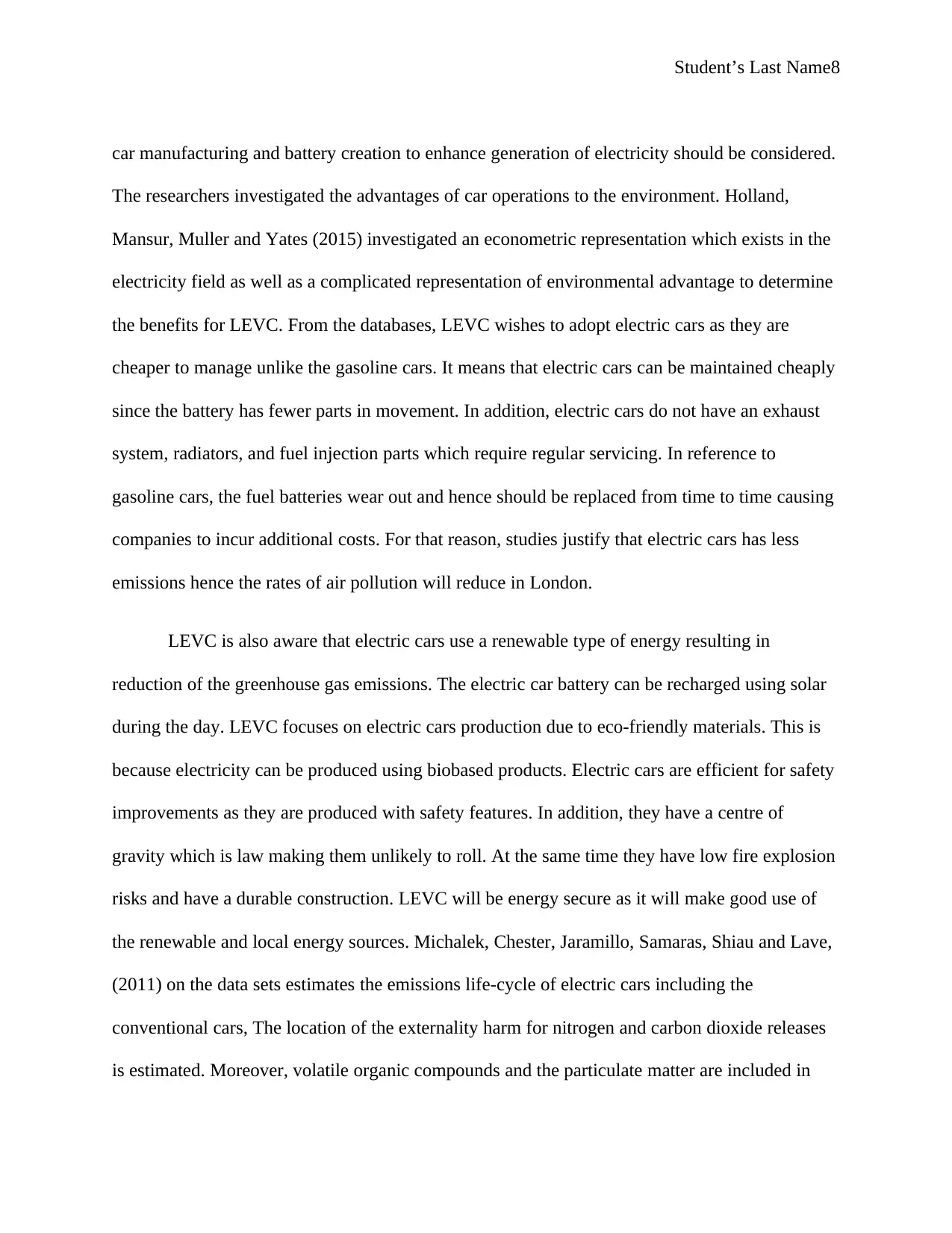
Student’s Last Name8
car manufacturing and battery creation to enhance generation of electricity should be considered.
The researchers investigated the advantages of car operations to the environment. Holland,
Mansur, Muller and Yates (2015) investigated an econometric representation which exists in the
electricity field as well as a complicated representation of environmental advantage to determine
the benefits for LEVC. From the databases, LEVC wishes to adopt electric cars as they are
cheaper to manage unlike the gasoline cars. It means that electric cars can be maintained cheaply
since the battery has fewer parts in movement. In addition, electric cars do not have an exhaust
system, radiators, and fuel injection parts which require regular servicing. In reference to
gasoline cars, the fuel batteries wear out and hence should be replaced from time to time causing
companies to incur additional costs. For that reason, studies justify that electric cars has less
emissions hence the rates of air pollution will reduce in London.
LEVC is also aware that electric cars use a renewable type of energy resulting in
reduction of the greenhouse gas emissions. The electric car battery can be recharged using solar
during the day. LEVC focuses on electric cars production due to eco-friendly materials. This is
because electricity can be produced using biobased products. Electric cars are efficient for safety
improvements as they are produced with safety features. In addition, they have a centre of
gravity which is law making them unlikely to roll. At the same time they have low fire explosion
risks and have a durable construction. LEVC will be energy secure as it will make good use of
the renewable and local energy sources. Michalek, Chester, Jaramillo, Samaras, Shiau and Lave,
(2011) on the data sets estimates the emissions life-cycle of electric cars including the
conventional cars, The location of the externality harm for nitrogen and carbon dioxide releases
is estimated. Moreover, volatile organic compounds and the particulate matter are included in
car manufacturing and battery creation to enhance generation of electricity should be considered.
The researchers investigated the advantages of car operations to the environment. Holland,
Mansur, Muller and Yates (2015) investigated an econometric representation which exists in the
electricity field as well as a complicated representation of environmental advantage to determine
the benefits for LEVC. From the databases, LEVC wishes to adopt electric cars as they are
cheaper to manage unlike the gasoline cars. It means that electric cars can be maintained cheaply
since the battery has fewer parts in movement. In addition, electric cars do not have an exhaust
system, radiators, and fuel injection parts which require regular servicing. In reference to
gasoline cars, the fuel batteries wear out and hence should be replaced from time to time causing
companies to incur additional costs. For that reason, studies justify that electric cars has less
emissions hence the rates of air pollution will reduce in London.
LEVC is also aware that electric cars use a renewable type of energy resulting in
reduction of the greenhouse gas emissions. The electric car battery can be recharged using solar
during the day. LEVC focuses on electric cars production due to eco-friendly materials. This is
because electricity can be produced using biobased products. Electric cars are efficient for safety
improvements as they are produced with safety features. In addition, they have a centre of
gravity which is law making them unlikely to roll. At the same time they have low fire explosion
risks and have a durable construction. LEVC will be energy secure as it will make good use of
the renewable and local energy sources. Michalek, Chester, Jaramillo, Samaras, Shiau and Lave,
(2011) on the data sets estimates the emissions life-cycle of electric cars including the
conventional cars, The location of the externality harm for nitrogen and carbon dioxide releases
is estimated. Moreover, volatile organic compounds and the particulate matter are included in
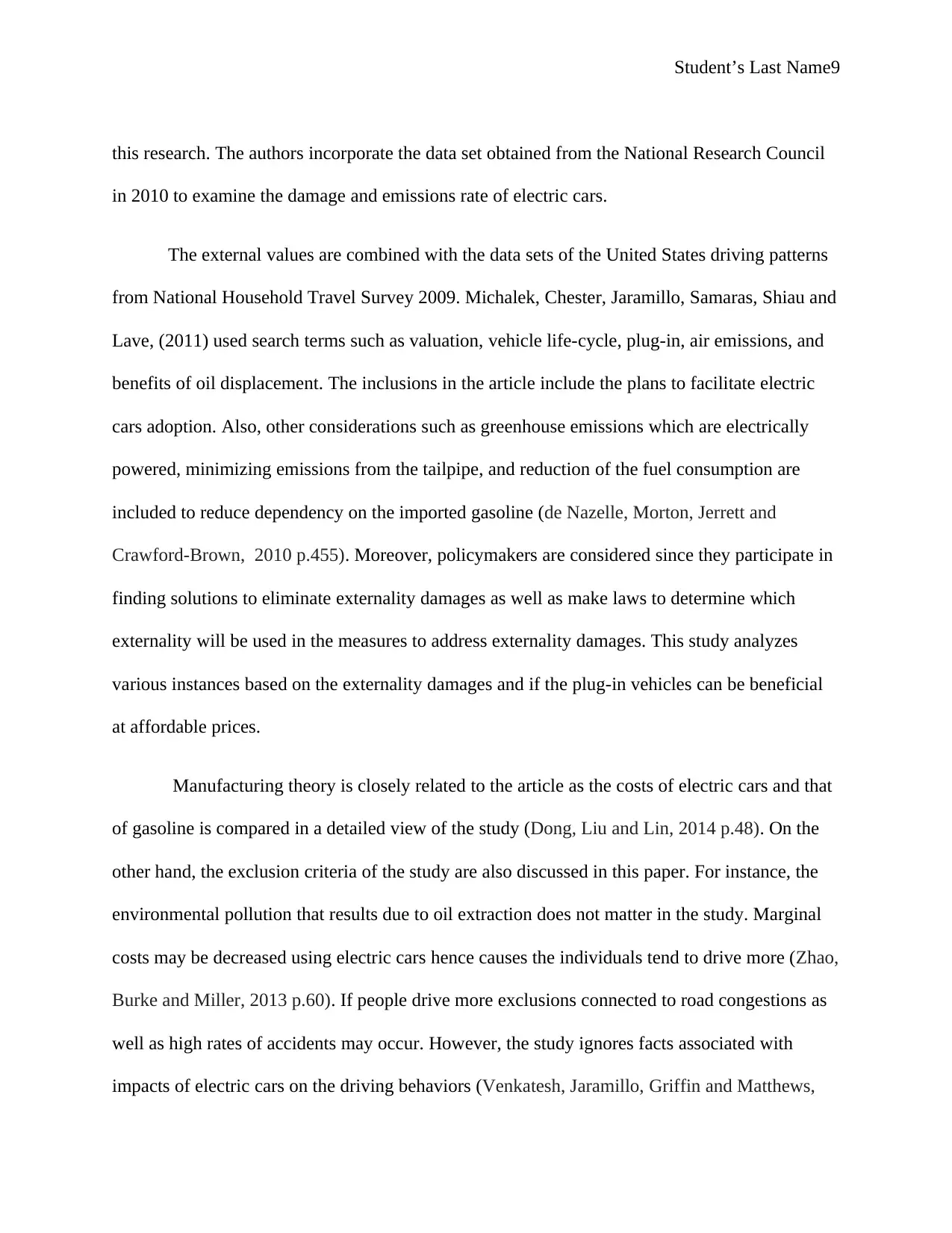
Student’s Last Name9
this research. The authors incorporate the data set obtained from the National Research Council
in 2010 to examine the damage and emissions rate of electric cars.
The external values are combined with the data sets of the United States driving patterns
from National Household Travel Survey 2009. Michalek, Chester, Jaramillo, Samaras, Shiau and
Lave, (2011) used search terms such as valuation, vehicle life-cycle, plug-in, air emissions, and
benefits of oil displacement. The inclusions in the article include the plans to facilitate electric
cars adoption. Also, other considerations such as greenhouse emissions which are electrically
powered, minimizing emissions from the tailpipe, and reduction of the fuel consumption are
included to reduce dependency on the imported gasoline (de Nazelle, Morton, Jerrett and
Crawford-Brown, 2010 p.455). Moreover, policymakers are considered since they participate in
finding solutions to eliminate externality damages as well as make laws to determine which
externality will be used in the measures to address externality damages. This study analyzes
various instances based on the externality damages and if the plug-in vehicles can be beneficial
at affordable prices.
Manufacturing theory is closely related to the article as the costs of electric cars and that
of gasoline is compared in a detailed view of the study (Dong, Liu and Lin, 2014 p.48). On the
other hand, the exclusion criteria of the study are also discussed in this paper. For instance, the
environmental pollution that results due to oil extraction does not matter in the study. Marginal
costs may be decreased using electric cars hence causes the individuals tend to drive more (Zhao,
Burke and Miller, 2013 p.60). If people drive more exclusions connected to road congestions as
well as high rates of accidents may occur. However, the study ignores facts associated with
impacts of electric cars on the driving behaviors (Venkatesh, Jaramillo, Griffin and Matthews,
this research. The authors incorporate the data set obtained from the National Research Council
in 2010 to examine the damage and emissions rate of electric cars.
The external values are combined with the data sets of the United States driving patterns
from National Household Travel Survey 2009. Michalek, Chester, Jaramillo, Samaras, Shiau and
Lave, (2011) used search terms such as valuation, vehicle life-cycle, plug-in, air emissions, and
benefits of oil displacement. The inclusions in the article include the plans to facilitate electric
cars adoption. Also, other considerations such as greenhouse emissions which are electrically
powered, minimizing emissions from the tailpipe, and reduction of the fuel consumption are
included to reduce dependency on the imported gasoline (de Nazelle, Morton, Jerrett and
Crawford-Brown, 2010 p.455). Moreover, policymakers are considered since they participate in
finding solutions to eliminate externality damages as well as make laws to determine which
externality will be used in the measures to address externality damages. This study analyzes
various instances based on the externality damages and if the plug-in vehicles can be beneficial
at affordable prices.
Manufacturing theory is closely related to the article as the costs of electric cars and that
of gasoline is compared in a detailed view of the study (Dong, Liu and Lin, 2014 p.48). On the
other hand, the exclusion criteria of the study are also discussed in this paper. For instance, the
environmental pollution that results due to oil extraction does not matter in the study. Marginal
costs may be decreased using electric cars hence causes the individuals tend to drive more (Zhao,
Burke and Miller, 2013 p.60). If people drive more exclusions connected to road congestions as
well as high rates of accidents may occur. However, the study ignores facts associated with
impacts of electric cars on the driving behaviors (Venkatesh, Jaramillo, Griffin and Matthews,
⊘ This is a preview!⊘
Do you want full access?
Subscribe today to unlock all pages.

Trusted by 1+ million students worldwide
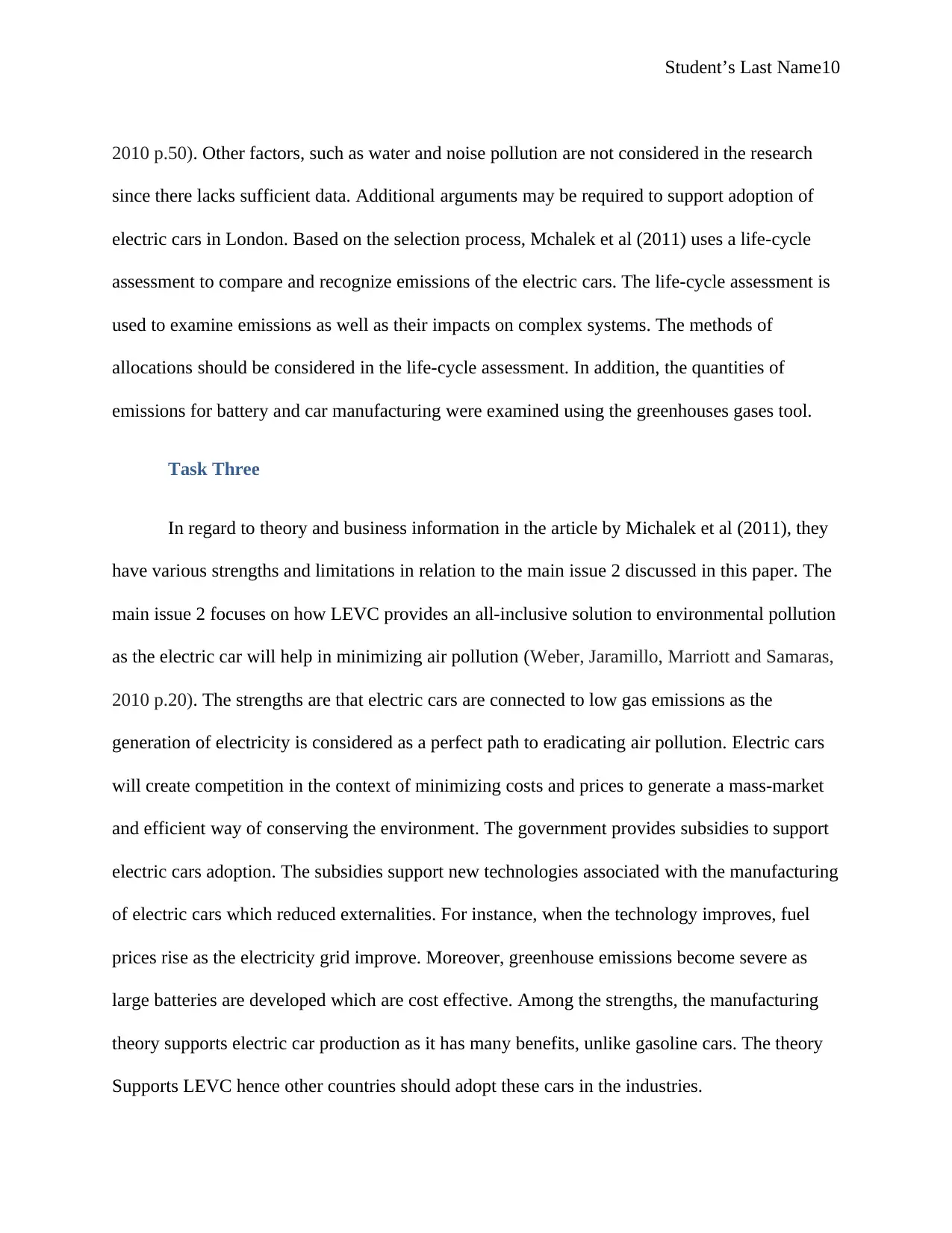
Student’s Last Name10
2010 p.50). Other factors, such as water and noise pollution are not considered in the research
since there lacks sufficient data. Additional arguments may be required to support adoption of
electric cars in London. Based on the selection process, Mchalek et al (2011) uses a life-cycle
assessment to compare and recognize emissions of the electric cars. The life-cycle assessment is
used to examine emissions as well as their impacts on complex systems. The methods of
allocations should be considered in the life-cycle assessment. In addition, the quantities of
emissions for battery and car manufacturing were examined using the greenhouses gases tool.
Task Three
In regard to theory and business information in the article by Michalek et al (2011), they
have various strengths and limitations in relation to the main issue 2 discussed in this paper. The
main issue 2 focuses on how LEVC provides an all-inclusive solution to environmental pollution
as the electric car will help in minimizing air pollution (Weber, Jaramillo, Marriott and Samaras,
2010 p.20). The strengths are that electric cars are connected to low gas emissions as the
generation of electricity is considered as a perfect path to eradicating air pollution. Electric cars
will create competition in the context of minimizing costs and prices to generate a mass-market
and efficient way of conserving the environment. The government provides subsidies to support
electric cars adoption. The subsidies support new technologies associated with the manufacturing
of electric cars which reduced externalities. For instance, when the technology improves, fuel
prices rise as the electricity grid improve. Moreover, greenhouse emissions become severe as
large batteries are developed which are cost effective. Among the strengths, the manufacturing
theory supports electric car production as it has many benefits, unlike gasoline cars. The theory
Supports LEVC hence other countries should adopt these cars in the industries.
2010 p.50). Other factors, such as water and noise pollution are not considered in the research
since there lacks sufficient data. Additional arguments may be required to support adoption of
electric cars in London. Based on the selection process, Mchalek et al (2011) uses a life-cycle
assessment to compare and recognize emissions of the electric cars. The life-cycle assessment is
used to examine emissions as well as their impacts on complex systems. The methods of
allocations should be considered in the life-cycle assessment. In addition, the quantities of
emissions for battery and car manufacturing were examined using the greenhouses gases tool.
Task Three
In regard to theory and business information in the article by Michalek et al (2011), they
have various strengths and limitations in relation to the main issue 2 discussed in this paper. The
main issue 2 focuses on how LEVC provides an all-inclusive solution to environmental pollution
as the electric car will help in minimizing air pollution (Weber, Jaramillo, Marriott and Samaras,
2010 p.20). The strengths are that electric cars are connected to low gas emissions as the
generation of electricity is considered as a perfect path to eradicating air pollution. Electric cars
will create competition in the context of minimizing costs and prices to generate a mass-market
and efficient way of conserving the environment. The government provides subsidies to support
electric cars adoption. The subsidies support new technologies associated with the manufacturing
of electric cars which reduced externalities. For instance, when the technology improves, fuel
prices rise as the electricity grid improve. Moreover, greenhouse emissions become severe as
large batteries are developed which are cost effective. Among the strengths, the manufacturing
theory supports electric car production as it has many benefits, unlike gasoline cars. The theory
Supports LEVC hence other countries should adopt these cars in the industries.
Paraphrase This Document
Need a fresh take? Get an instant paraphrase of this document with our AI Paraphraser
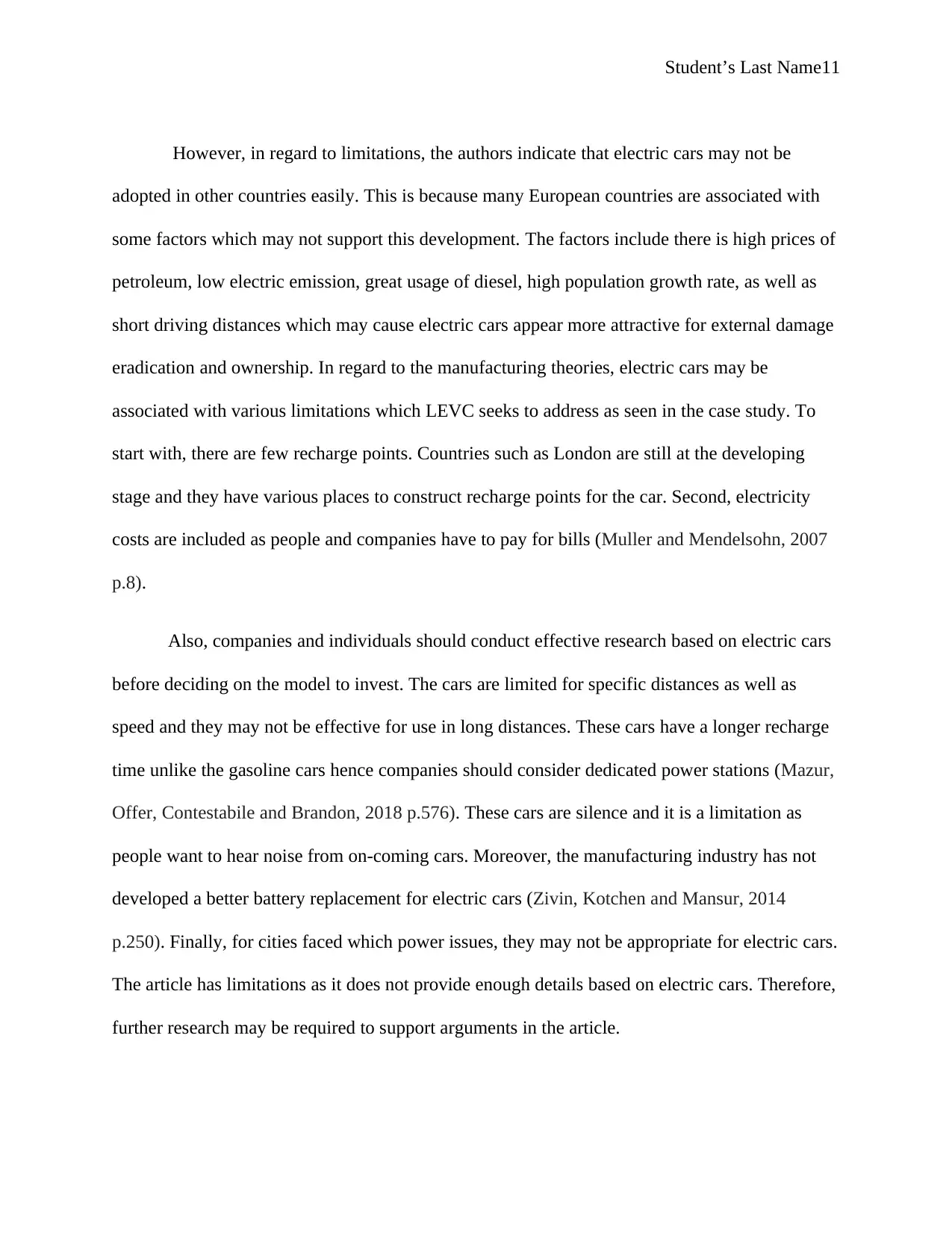
Student’s Last Name11
However, in regard to limitations, the authors indicate that electric cars may not be
adopted in other countries easily. This is because many European countries are associated with
some factors which may not support this development. The factors include there is high prices of
petroleum, low electric emission, great usage of diesel, high population growth rate, as well as
short driving distances which may cause electric cars appear more attractive for external damage
eradication and ownership. In regard to the manufacturing theories, electric cars may be
associated with various limitations which LEVC seeks to address as seen in the case study. To
start with, there are few recharge points. Countries such as London are still at the developing
stage and they have various places to construct recharge points for the car. Second, electricity
costs are included as people and companies have to pay for bills (Muller and Mendelsohn, 2007
p.8).
Also, companies and individuals should conduct effective research based on electric cars
before deciding on the model to invest. The cars are limited for specific distances as well as
speed and they may not be effective for use in long distances. These cars have a longer recharge
time unlike the gasoline cars hence companies should consider dedicated power stations (Mazur,
Offer, Contestabile and Brandon, 2018 p.576). These cars are silence and it is a limitation as
people want to hear noise from on-coming cars. Moreover, the manufacturing industry has not
developed a better battery replacement for electric cars (Zivin, Kotchen and Mansur, 2014
p.250). Finally, for cities faced which power issues, they may not be appropriate for electric cars.
The article has limitations as it does not provide enough details based on electric cars. Therefore,
further research may be required to support arguments in the article.
However, in regard to limitations, the authors indicate that electric cars may not be
adopted in other countries easily. This is because many European countries are associated with
some factors which may not support this development. The factors include there is high prices of
petroleum, low electric emission, great usage of diesel, high population growth rate, as well as
short driving distances which may cause electric cars appear more attractive for external damage
eradication and ownership. In regard to the manufacturing theories, electric cars may be
associated with various limitations which LEVC seeks to address as seen in the case study. To
start with, there are few recharge points. Countries such as London are still at the developing
stage and they have various places to construct recharge points for the car. Second, electricity
costs are included as people and companies have to pay for bills (Muller and Mendelsohn, 2007
p.8).
Also, companies and individuals should conduct effective research based on electric cars
before deciding on the model to invest. The cars are limited for specific distances as well as
speed and they may not be effective for use in long distances. These cars have a longer recharge
time unlike the gasoline cars hence companies should consider dedicated power stations (Mazur,
Offer, Contestabile and Brandon, 2018 p.576). These cars are silence and it is a limitation as
people want to hear noise from on-coming cars. Moreover, the manufacturing industry has not
developed a better battery replacement for electric cars (Zivin, Kotchen and Mansur, 2014
p.250). Finally, for cities faced which power issues, they may not be appropriate for electric cars.
The article has limitations as it does not provide enough details based on electric cars. Therefore,
further research may be required to support arguments in the article.
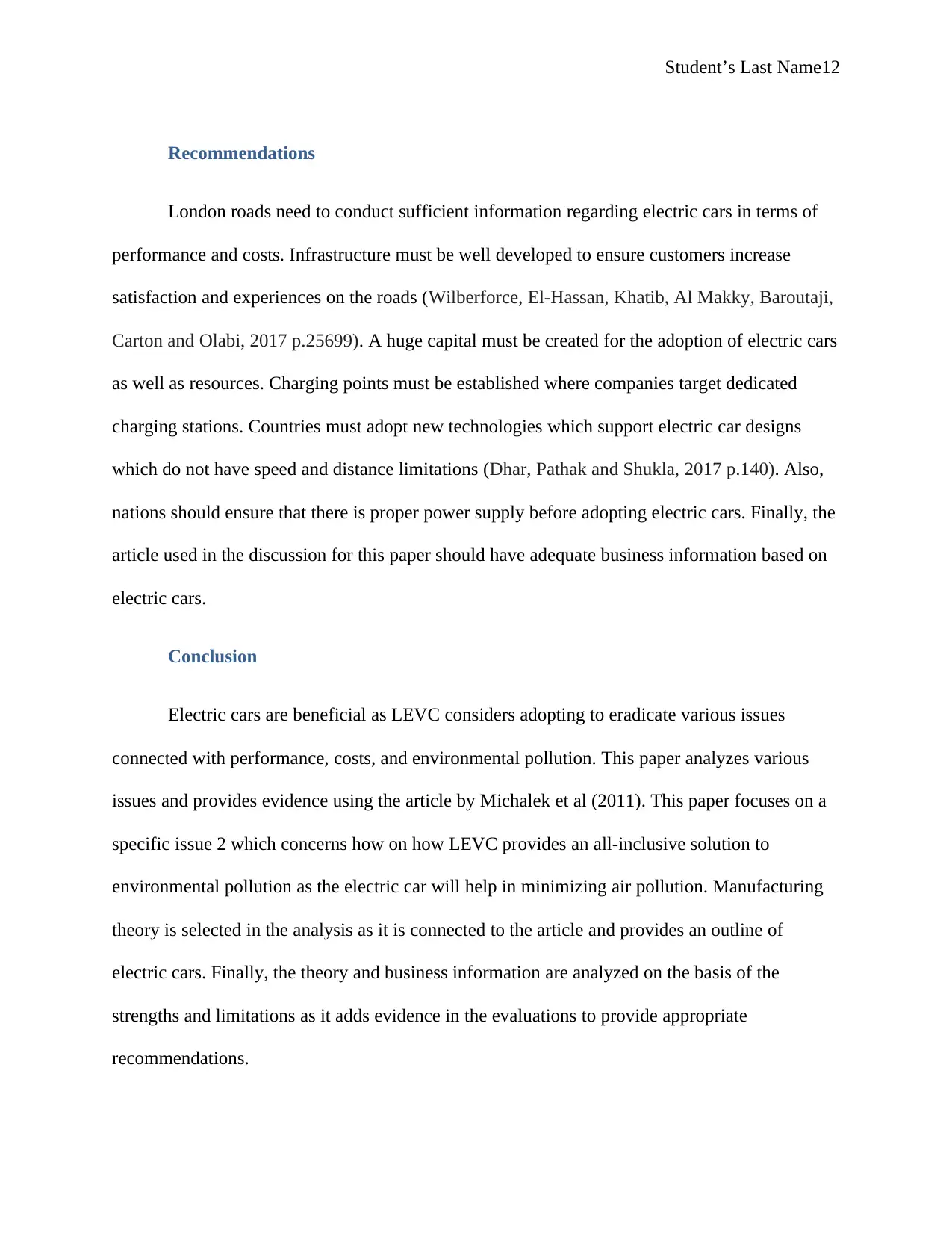
Student’s Last Name12
Recommendations
London roads need to conduct sufficient information regarding electric cars in terms of
performance and costs. Infrastructure must be well developed to ensure customers increase
satisfaction and experiences on the roads (Wilberforce, El-Hassan, Khatib, Al Makky, Baroutaji,
Carton and Olabi, 2017 p.25699). A huge capital must be created for the adoption of electric cars
as well as resources. Charging points must be established where companies target dedicated
charging stations. Countries must adopt new technologies which support electric car designs
which do not have speed and distance limitations (Dhar, Pathak and Shukla, 2017 p.140). Also,
nations should ensure that there is proper power supply before adopting electric cars. Finally, the
article used in the discussion for this paper should have adequate business information based on
electric cars.
Conclusion
Electric cars are beneficial as LEVC considers adopting to eradicate various issues
connected with performance, costs, and environmental pollution. This paper analyzes various
issues and provides evidence using the article by Michalek et al (2011). This paper focuses on a
specific issue 2 which concerns how on how LEVC provides an all-inclusive solution to
environmental pollution as the electric car will help in minimizing air pollution. Manufacturing
theory is selected in the analysis as it is connected to the article and provides an outline of
electric cars. Finally, the theory and business information are analyzed on the basis of the
strengths and limitations as it adds evidence in the evaluations to provide appropriate
recommendations.
Recommendations
London roads need to conduct sufficient information regarding electric cars in terms of
performance and costs. Infrastructure must be well developed to ensure customers increase
satisfaction and experiences on the roads (Wilberforce, El-Hassan, Khatib, Al Makky, Baroutaji,
Carton and Olabi, 2017 p.25699). A huge capital must be created for the adoption of electric cars
as well as resources. Charging points must be established where companies target dedicated
charging stations. Countries must adopt new technologies which support electric car designs
which do not have speed and distance limitations (Dhar, Pathak and Shukla, 2017 p.140). Also,
nations should ensure that there is proper power supply before adopting electric cars. Finally, the
article used in the discussion for this paper should have adequate business information based on
electric cars.
Conclusion
Electric cars are beneficial as LEVC considers adopting to eradicate various issues
connected with performance, costs, and environmental pollution. This paper analyzes various
issues and provides evidence using the article by Michalek et al (2011). This paper focuses on a
specific issue 2 which concerns how on how LEVC provides an all-inclusive solution to
environmental pollution as the electric car will help in minimizing air pollution. Manufacturing
theory is selected in the analysis as it is connected to the article and provides an outline of
electric cars. Finally, the theory and business information are analyzed on the basis of the
strengths and limitations as it adds evidence in the evaluations to provide appropriate
recommendations.
⊘ This is a preview!⊘
Do you want full access?
Subscribe today to unlock all pages.

Trusted by 1+ million students worldwide
1 out of 15
Related Documents
Your All-in-One AI-Powered Toolkit for Academic Success.
+13062052269
info@desklib.com
Available 24*7 on WhatsApp / Email
![[object Object]](/_next/static/media/star-bottom.7253800d.svg)
Unlock your academic potential
Copyright © 2020–2025 A2Z Services. All Rights Reserved. Developed and managed by ZUCOL.





